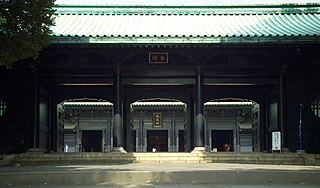
Osahito, posthumously honored as Emperor Kōmei, was the 121st emperor of Japan, according to the traditional order of succession. Kōmei's reign spanned the years from 1846 through 1867, corresponding to the final years of the Edo period.

Bakumatsu were the final years of the Edo period when the Tokugawa shogunate ended. Between 1853 and 1867, under foreign diplomatic and military pressure, Japan ended its isolationist foreign policy known as sakoku and changed from a feudal Tokugawa shogunate to the modern empire of the Meiji government. The major ideological-political divide during this period was between the pro-imperial nationalists called ishin shishi and the shogunate forces, which included the elite shinsengumi swordsmen.
The Ansei Purge was a multi-year event during the Bakumatsu period of Japanese history, between 1858 and 1860, during which the Tokugawa shogunate imprisoned, executed, or exiled those who did not support its authority and foreign trade policies. The purge was undertaken by Ii Naosuke in opposition to Imperial Loyalists.

Keiō was a Japanese era name after Genji and before Meiji. The period spanned the years from May 1865 to October 1868. The reigning emperors were Kōmei-tennō (孝明天皇) and Meiji-tennō (明治天皇).

Izu Province was a province of Japan in the area now part of Shizuoka Prefecture and Tokyo. Izu bordered on Sagami and Suruga Provinces. Its abbreviated form name was Zushū (豆州).

Tokugawa Iemochi was the 14th shōgun of the Tokugawa shogunate of Japan, who held office from 1858 to 1866. During his reign there was much internal turmoil as a result of the "re-opening" of Japan to western nations. Iemochi's reign also saw a weakening of the shogunate.

Tokugawa Iesada was the 13th shōgun of the Tokugawa shogunate of Japan. He held office for five years from 1853 to 1858. He was physically weak and was therefore considered by later historians to have been unfit to be shōgun. His reign marks the beginning of the Bakumatsu period.

Ii Naosuke was a daimyō of Hikone (1850–1860) and also Tairō of the Tokugawa shogunate, Japan, a position he held from April 23, 1858, until his death, when he was assassinated in the Sakuradamon Incident on March 24, 1860. He is most famous for signing the Harris Treaty with the United States, granting access to ports for trade to American merchants and seamen and extraterritoriality to American citizens. He was also an enthusiastic and accomplished practitioner of the Japanese tea ceremony, in the Sekishūryū style, and his writings include at least two works on the tea ceremony.

Nankaidō is a Japanese geographical term. It means both an ancient division of the country and the main road running through it. The road connected provincial capitals in this region. It was part of the Gokishichidō system.

Man'en (万延) was a Japanese era name after Ansei and before Bunkyū. This period spanned the years from March 1860 through February 1861. The reigning emperor was Kōmei-tennō (孝明天皇).

Kaei (嘉永) was a Japanese era name after Kōka and before Ansei. This period spanned the years from February 1848 through November 1854. The reigning emperor was Kōmei-tennō (孝明天皇).

Meireki (明暦) was a Japanese era name of the Edo period, after the Jōō era and before Manji era. This era's period spanned the years from April 1655 to July 1658.

Keichō (慶長) was a Japanese era name after Bunroku and before Genna. This period spanned from October 1596 to July 1615. The reigning emperors were Go-Yōzei-tennō (後陽成天皇) and Go-Mizunoo-tennō (後水尾天皇).

Hotta Masayoshi was the 5th Hotta daimyō of the Sakura Domain in the Japanese Edo period, who served as chief rōjū in the Bakumatsu period Tokugawa shogunate, where he played an important role in the negotiations of the Ansei Treaties with various foreign powers.

Bunkyū (文久) was a Japanese era name after Man'en and before Genji. This period spanned the years from March 1861 through March 1864. The reigning emperor was Kōmei-tennō (孝明天皇).

Hayashi Akira was an Edo period scholar-diplomat serving the Tokugawa shogunate in a variety of roles similar to those performed by serial Hayashi clan neo-Confucianists since the time of Tokugawa Ieyasu. He was the hereditary Daigaku-no-kami descendant of Hayashi Razan, the first head of the Tokugawa shogunate's neo-Confucian academy in Edo, the Shōhei-kō.

The Ansei great earthquakes were a series of major earthquakes that struck Japan during the Ansei era (1854–1860):
Kōbu gattai was a policy in the Bakumatsu era of Japanese history aiming to strengthen Japan against the perceived "foreign threat" by obtaining a political coordination between the Tokugawa shogunate, certain major feudal domains and the Japanese Imperial Court.
Daigaku-no-kami (大学頭) was a Japanese Imperial court position and the title of the chief education expert in the rigid court hierarchy. The Imperial Daigaku-no-kami predates the Heian period; and the court position continued up through the early Meiji period. The title and position were conferred in the name of the Emperor of Japan.

The 1855 Edo earthquake, was the third Ansei Great Earthquake, which occurred during the late-Edo period. It occurred after the 1854 Nankai earthquake, which took place about a year prior. The earthquake occurred at 22:00 local time on 11 November. It had an epicenter close to Edo, causing considerable damage in the Kantō region from the shaking and subsequent fires, with a death toll of 7,000–10,000 people and destroyed around 14,000 buildings. The earthquake had a magnitude of 7.0 on the surface wave magnitude scale and reached a maximum intensity of XI (Extreme) on the Mercalli intensity scale. The earthquake triggered a minor tsunami.













